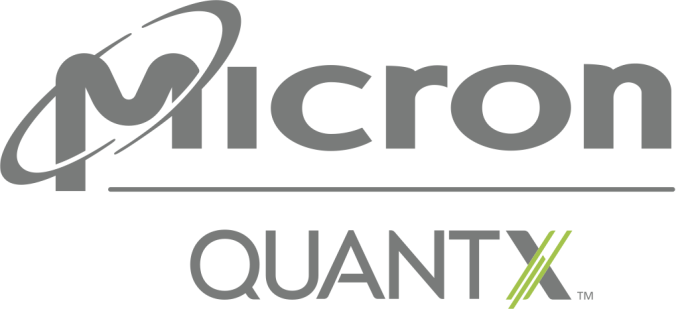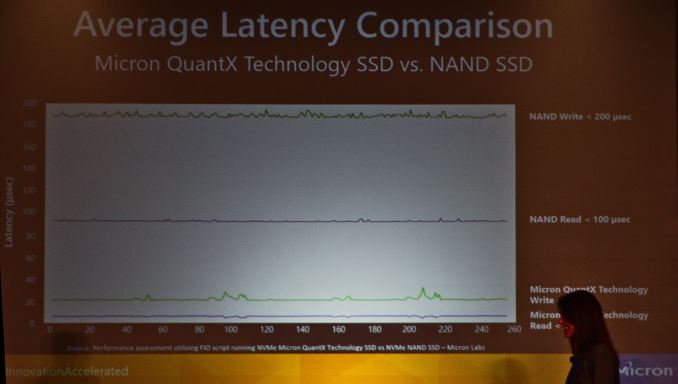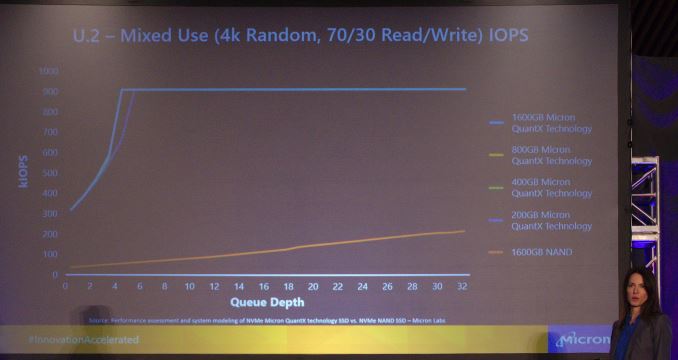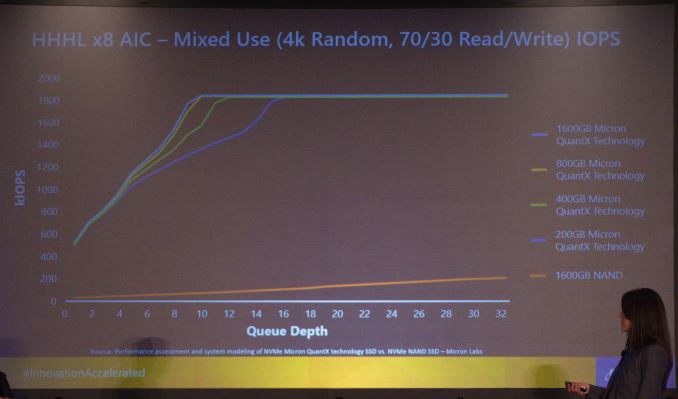Micron Announces QuantX Branding For 3D XPoint Memory (UPDATED)
by Billy Tallis on August 9, 2016 10:45 AM EST- Posted in
- SSDs
- Micron
- 3D XPoint
- Flash Memory Summit
- QuantX

In a keynote speech later this morning at Flash Memory Summit, Micron will be unveiling the branding and logo that their products based on 3D XPoint memory will be using. The new QuantX brand is Micron's counterpart to Intel's Optane brand and will be used for the NVMe storage products that we will hear more about later this year. 3D Xpoint memory was jointly announced by Intel and Micron shortly before last year's Flash Memory Summit and we analyzed the details that were available at the time. Since then there has been very little new official information but much speculation. We do know that the initial products will be NVMe SSDs rather than NVDIMMs or other memory bus attached devices.
In the meantime, Micron VP Darren Thomas goes on stage at 11:30 AM PT, and we'll update with any further information.
UPDATE:
Micron's keynote reiterated their strategy of positioning 3D XPoint and thus QuantX products in between NAND flash and DRAM, with the advantages of 3d XPoint relative to each highlighted (while the disadvantages go unmentioned). But then they moved on to showing some meaningful performance graphs from actual benchmarks of QuantX drives.
The factor of ten improvement in both read and write latency for NVMe drives is great, but perhaps the more impressive results are the graphs showing queue depth scaling. In a comparison of U.2 NVMe drives, Micron showed performance of QuantX drives ranging from 200GB to 1600GB, relative to a 1600GB NAND flash NVMe SSD. The QuantX drives saturated the PCIe x4 link with a 70/30 mix of random reads and random writes with queue depths of just 4-6, while the NAND SSD gets nowhere close to saturating the link with random accesses. The next comparison was of the PCIe x8 add-in card performance, where the link was saturated with queue depths between 10 and 16, depending on the capacity of the QuantX drive.
This great performance at low queue depths will make it relatively easy for a wide variety of workloads to benefit from the raw performance 3D XPoint memory offers. By contrast, the biggest and fastest PCIe SSDs based on NAND flash often require careful planning on the software side to achieve full utilization.
Source: Micron



















52 Comments
View All Comments
lilmoe - Tuesday, August 9, 2016 - link
They're holding back too darn much with this one. Get it out in the wild already.............IO is the next big thing in computing it seams.
rahvin - Tuesday, August 9, 2016 - link
There are several potential competitive technologies on the edge of production. They do not want to tip their hand until the product is shipping. This is creating doubt in the competitive tech's and will give Intel/Micron an edge. This is business 101. They probably won't say a word until you can buy it.frenchy_2001 - Tuesday, August 9, 2016 - link
True, but still disappointing from intel and Micron.They announced it LAST YEAR, at the same show. saying it would come to market "fairly soon".
This was rather disingenuous, as we can see a year later, and done purely to handicap competing techs (many companies are working on similar products, all claiming "soon").
I expected better from intel. They are usually much better at their introduction estimation and this announcement feels like they abused that trust.
Kevin G - Wednesday, August 10, 2016 - link
The expectation was that NVMe solutions would arrive in 2016 and NVDIMM solutions to launch shortly after SkyLake-EP (due in 2017).Refuge - Wednesday, August 10, 2016 - link
I mean... I love and adore Intel because they have fed/clothed/housed me for the first half of my life (Dad just retired this year).But being close with the company and the goings on I can say that I would never expect better than this from them.
They are good, too good at times even. But they didn't get to where they are right now by playing fair and nice. They will cock-shot the competition anytime they can get away with it.
ddriver - Wednesday, August 10, 2016 - link
Don't waste your love, intel has definitely taken from your dad more than they've paid him for. If they didn't, they wouldn't be posting such high profits. Intel is a big, greedy and quite frankly lazy monopolist, they've barely made any improvements the last few years, and wherever they did it isn't really worth it. iGPUs have improved quite a lot, but most people out there would prefer that silicon invested in twice the core count rather than mediocre graphics, and sure, they have added more cores to certain product lines, but at very high cost and poor purchase value. They also miserably failed in the mobile device, and practically gave up on that market, IMO because their business model cannot do with the kind of slim profit margins ARM chips have made standard for mobile. Intel are in lazy mode, and if by chance they release something that's actually new and better, it will undoubtedly cost an arm and a leg, not because it is that expensive to manufacture, but because of shameless profit margins.Samus - Wednesday, August 10, 2016 - link
I agree. Intel has been incredibly lazy since the Core microarchitecture, and completely threw in the towel around Nehalem/Sandybridge (2008-2010) and we all know why.No competition. AMD basically challenged Intel when we are being fed crap like Netburst, and Intel works fantastic under pressure and fired back hard while starving AMD of OEM contracts. The problem now is obviously there is no pressure, but there is also no sign Intel is going to take the risks they took with Netburst again to give the competition the "in" they need to compete.
ddriver - Thursday, August 11, 2016 - link
At this point it looks like xpoint is about 95% hype, meaning that it will offer about 5% of the benefits intel claimed. Density is pathetically low, much lower than 3d nand, endurance is only like 2.5 better than MLC (which would make it lower than SLC), real world tests indicate it will be 2-3x better than current enterprise PCIe SSDs, and largely due to the controller, which SSDs can easily improve upon. At this rate, intel's claims of "affordability" will end up being just as bogus as the performance claims, and by the time actual products arrive, samsung's stacked SLC will be trashing it.Samus - Wednesday, August 10, 2016 - link
I'd suspect the reason for delaying its launch is demand. There is little real-world application for this right now because platforms and software are not really designed to take advantage of ultra-fast IO...perhaps Micron is waiting on Intel's partners for a balls deep launch.Sadly, the majority of consumers from SMB to Enterprise are satisfied with SATA solutions, hence the rarity of SAS SSD's. For those that need more, there are PCIe SSD's in a variety of formats offering 2000+MB/sec performance, and even this is grossly unutilized is almost all non-application specific scenario's.
What Intel and Micron have here is at the end of the day bottlenecked by the interconnects of the platform, specifically, common network infrastructure. Even teamed 10-Gigabit implementations will be easily saturated by a single PCIe 8x SSD. So there is no realistic application for datacenters, either.
As of right now, the only market for this thing is ultra-heavy databases (like...millions of IOPS) and linear 8K video editing, an equally niche market. This is, after all, the first real jump in storage innovation in over a decade.
Anato - Thursday, August 11, 2016 - link
They were sampling these year ago. I seriously doubt they can keep performance secret from competitors (like Samsung, SK Hynix, IBM). I'd be surprised if competitors haven't got XPoint under microscope soon after sampling or at least report from microscopy analysis.